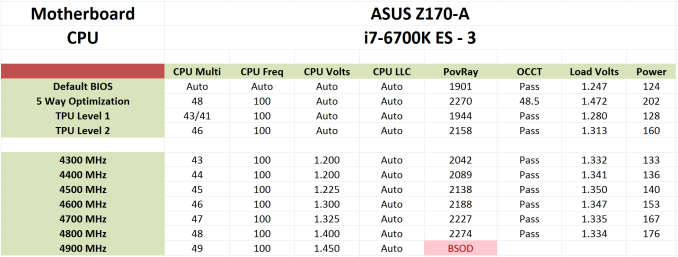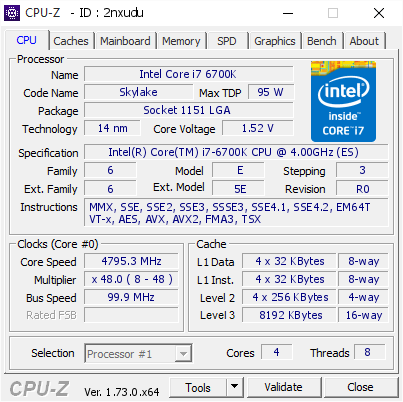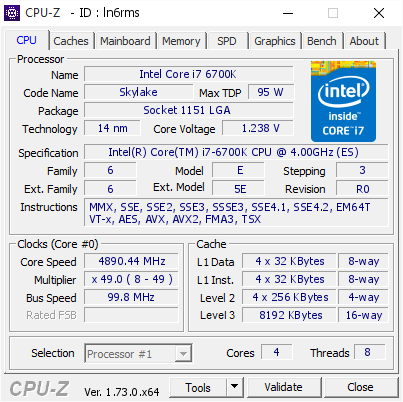The Intel Skylake i7-6700K Overclocking Performance Mini-Test to 4.8 GHz
by Ian Cutress on August 28, 2015 2:30 PM EST
At the time of our Skylake review of both the i7-6700K and the i5-6600K, due to the infancy of the platform and other constraints, we were unable to probe the performance uptake of the processors as they were overclocked. Our overclock testing showed that 4.6 GHz was a reasonable marker for our processors; however fast forward two weeks and that all seems to change as updates are released. With a new motherboard and the same liquid cooler, the same processor that performed 4.6 GHz gave 4.8 GHz with relative ease. In this mini-test, we tested our short-form CPU workload as well as integrated and discrete graphics at several frequencies to see where the real gains are.
In the Skylake review we stated that 4.6 GHz still represents a good target for overclockers to aim for, with 4.8 GHz being indicative of a better sample. Both ASUS and MSI have also stated similar prospects in their press guides that accompany our samples, although as with any launch there is some prospect that goes along with the evolution of understanding the platform over time.
In this mini-test (performed initially in haste pre-IDF, then extra testing after analysing the IGP data), I called on a pair of motherboards - ASUS's Z170-A and ASRock's Z170 Extreme7+ - to provide a four point scale in our benchmarks. Starting with the 4.2 GHz frequency of the i7-6700K processor, we tested this alongside every 200 MHz jump up to 4.8 GHz in both our shortened CPU testing suite as well as iGPU and GTX 980 gaming. Enough of the babble – time for fewer words and more results!


We actually got the CPU to 4.9 GHz, as shown on the right, but it was pretty unstable for even basic tasks.
(Voltage is read incorrectly on the right.)
OK, a few more words before results – all of these numbers can be found in our overclocking database Bench alongside the stock results and can be compared to other processors.
Test Setup
| Test Setup | |
| Processor | Intel Core i7-6700K (ES, Retail Stepping), 91W, $350 4 Cores, 8 Threads, 4.0 GHz (4.2 GHz Turbo) |
| Motherboards | ASUS Z170-A ASRock Z170 Extreme7+ |
| Cooling | Cooler Master Nepton 140XL |
| Power Supply | OCZ 1250W Gold ZX Series Corsair AX1200i Platinum PSU |
| Memory | Corsair DDR4-2133 C15 2x8 GB 1.2V or G.Skill Ripjaws 4 DDR4-2133 C15 2x8 GB 1.2V |
| Memory Settings | JEDEC @ 2133 |
| Video Cards | ASUS GTX 980 Strix 4GB ASUS R7 240 2GB |
| Hard Drive | Crucial MX200 1TB |
| Optical Drive | LG GH22NS50 |
| Case | Open Test Bed |
| Operating System | Windows 7 64-bit SP1 |
The dynamics of CPU Turbo modes, both Intel and AMD, can cause concern during environments with a variable threaded workload. There is also an added issue of the motherboard remaining consistent, depending on how the motherboard manufacturer wants to add in their own boosting technologies over the ones that Intel would prefer they used. In order to remain consistent, we implement an OS-level unique high performance mode on all the CPUs we test which should override any motherboard manufacturer performance mode.
Many thanks to...
We must thank the following companies for kindly providing hardware for our test bed:
Thank you to AMD for providing us with the R9 290X 4GB GPUs.
Thank you to ASUS for providing us with GTX 980 Strix GPUs and the R7 240 DDR3 GPU.
Thank you to ASRock and ASUS for providing us with some IO testing kit.
Thank you to Cooler Master for providing us with Nepton 140XL CLCs.
Thank you to Corsair for providing us with an AX1200i PSU.
Thank you to Crucial for providing us with MX200 SSDs.
Thank you to G.Skill and Corsair for providing us with memory.
Thank you to MSI for providing us with the GTX 770 Lightning GPUs.
Thank you to OCZ for providing us with PSUs.
Thank you to Rosewill for providing us with PSUs and RK-9100 keyboards.










103 Comments
View All Comments
kmmatney - Friday, August 28, 2015 - link
The G3258 is fun to overclock. The overclock on my Devils Canyon i5 made a difference on my server, which runs 3 minecraft servers at the same time. I needed the overclock to make up for the lousy optimization of Java on the WHS 2011 OS.StrangerGuy - Saturday, August 29, 2015 - link
Yeah, spend $340 on a 6700K, $200 on a mobo, $100 on a cooler for measly 15% CPU OC, all for a next to zero real world benefit in single GPU gaming loads compared to a $250 locked i5 / budget mobo.Who cares about how easy you can perform the OC when the value for money is rubbish.
hasseb64 - Saturday, August 29, 2015 - link
You nailed it stranger!Beaver M. - Saturday, August 29, 2015 - link
You should have known that before, that even without overclock your CPU will be so fast that you wont be seeing any difference in most games when overclocking.Deders - Saturday, August 29, 2015 - link
If you intend to keep the hardware for a long period of time it can help. My previous i5-750's 3800MHz overclock made it viable as a gaming processor for the 5 or so years I was using it.For example it allowed me to play Arkham City with full PhysX on a single 560TI, at stock speeds it wasn't playable with these settings. The most recent Batman game was no problem for it even though many people were having issues, same goes for Watchdogs.
qasdfdsaq - Wednesday, September 2, 2015 - link
Sure, and my 50% overclock on my i7 920 made it viable for my main gaming PC for a few years longer than it otherwise would have been, but a 10-15% overclock? With a <1% gaming performance increase? Meh.Impulses - Saturday, August 29, 2015 - link
You're exaggerating the basic requirements tho, I'm sure some do that, but I've never paid $200 or $100 for a cooler ($160/65 tops)... And if you spent more on the i7 it damn better had been for HT or you've no clue what you're doing...Xenonite - Saturday, August 29, 2015 - link
@V900: "Today, processors have gotten so fast, that even the cheap 200$ CPUs are "fast enough" for most tasks."For almost all non-gaming tasks (except realtime frame interpolation) this is most certainly true. The thing is, CPUs are NOT even nearly fast enough to game at 140+ fps with the 99% frame latency at a suitable <8mS value.
I realize that no one cares about >30fps gaming and that most people even condemn it as "looking to real" (in the same sentence as "your eyes can't even see a difference anyway"), therefore games aren't being optimised for low 99% frame latencies, and neither are modern CPUs.
But for the few of us who are sensitive to 1ms frametime variances in sub-10ms average frame latency streams, overclocking to high clock speeds is the only way to approach relatively smooth frame delivery.
On the same note, I would really have loved to see an FCAT or at least a FRAPS comparison of 99% frametimes between the different overclocked states, with a suitably overclocked GTX 980ti and some high-speed DDR4 memory along with the in-game settings being dialed back a bit (at least for the 1080p test).
EMM81 - Saturday, August 29, 2015 - link
"CPUs are NOT even nearly fast enough to game at 140+ fps" "But for the few of us who are sensitive to 1ms frametime variances in sub-10ms average frame latency streams"1) People may care about 30-60+fps but where do you get 140 from???
2) You are not sensitive to 1ms frametime variations...going from 33.3ms-16.7ms(30-60fps) makes only a very subtle difference to most people and that is a 16.6ms(0.5x) delta. There is zero possible way you can perceive anywhere near that level of difference. Even if we were talking about running at 60fps with a variation of 2ms and you could somehow stare at a side by side comparison until you maybe were able to pick out the difference why does it matter??? You care more about what the numbers say and how cool you think it is...
Communism - Saturday, August 29, 2015 - link
Take your pseudo-intellectualism elsewhere.